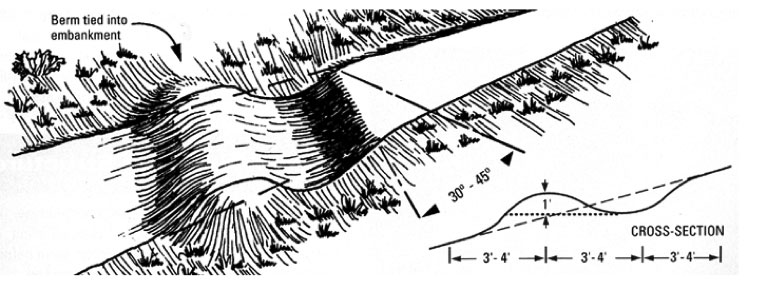 Ask the Steward
Ask the Steward
Question: I’ve never been to a water bar. Where can I find one?
Answer: You’ve come to the right place. I’ve been to quite a few water bars over the years and have actually helped build several- and you can to! As woodland owners with sloping trails and access roads a water bar is an important feature to prevent soil erosion and insure trail sustainability. Waterbars are most often a simple mound of soil, about 12 inches in height, built up diagonally across the road or trail to divert water from the road in small quantities before it can build up force to cause excessive soil erosion. Along the uphill side of the waterbar it is necessary to excavate a shallow trough (12” deep) to help channel water along the water bar, off the trail and onto a stable vegetated area. Spacing of these water diversions is based on slope steepness with a good rule of thumb being to install a waterbar every 6’ of elevation change, AND also before roads and trails cross stream channels. While they can be constructed by hand, bladed heavy equipment sure makes the job easier. For extra stability seed and mulch the waterbars to establish good vegetated cover. When selling timber it is strongly recommended that the sale contract include language about best management practices for soil and water conservation- including the required use of waterbars on sloping logging roads and trails. Learn more about waterbars with a simple web search on ‘forestry waterbars’.
Drawing from Wisconsin’s Forestry Best Management Practices for Water Quality (1995).
Question: The chain brake on my chainsaw broke. Is the saw still safe to use?
Answer: Not in my book! While the saw may still function and even cut wood well, the chain brake is one of the most important safety features on today’s chainsaws. And, as many emergency rooms can tell you when chainsaw accidents happens they are not pretty and can be very injurious or deadly. This safety feature protects against dangerous chainsaw kickback by stopping the chain quickly when the brake is triggered under a kickback condition. The chain brake should also be manually activated by the saw operator during saw start-ups and when moving about while not cutting. This helps avoid accidents and injuries by minimizing uncontrolled chain movement. While we are on the safe use of chainsaws- consider these additional must do’s. 1) Do use safety gear. This includes chainsaw chaps, gloves, heavy boots, eye, ear and head protection. A 3-in-1 safety helmet with a face shield and integrated earmuffs are a must for me and should be in every woodland owner’s safety kit. 2) Don’t work when you are tired. Statistics show that accidents increase near the end of the work day after and when fatigued. 3) Don’t cut what you cannot handle. There are many dangerous trees in the forest and unless well experienced you should stay clear of them. This includes trees bent over and under stress, trees with dead snags and branches overhead (also known as widow makers), and hollow trees with little solid wood. 4) Keep your saw sharp. Not only will it make work much easier- a sharp saw is a safer saw. They cut straighter, pinches less and reduced fatigue on the operator and the saw. 5) And lastly- work with a buddy and keep each other safe. Across Indiana chainsaw safety classes are periodically offered. Take the time to attend one regardless of your level of experience. And, take your buddy with you!
Dan Ernst is an Assistant State Forester with the Indiana Division of Forestry. He oversees the state forests in Indiana and has authored the “Ask the Steward” column for years. Have a question for the column? Email Dan at dernst@dnr.in.gov.
